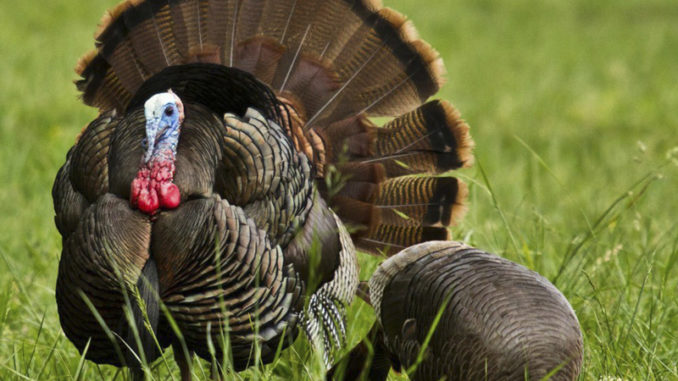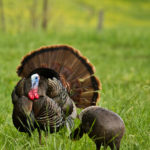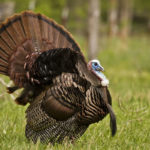
Wilkes County call-maker has ideas about working birds that are especially difficult.
Very few wild turkeys are “easy” for hunters, but some are easier than others. Those gobblers that gobble at your first call on opening day and sail down within shotgun range fit in this category. The ones that respond this way wind up 30 yards off the end of your shotgun barrel within 30 minutes.
By far, more turkeys are “tough” birds. They don’t need you to make any mistakes. But they certainly take advantage of anything you do wrong to stay alive. And they don’t really need a reason not to walk into range. Sometimes, they just don’t want to. You leave the woods after dealing with one of these hook-spurred long-beards properly chastened that you ever thought you might approach being a good hunter.
Mitchell Johnson of the Wilkes County community of Purlear recognizes that these birds exist. And he has some ideas about how to outwit them. The owner of Dead End Game Calls (336-973-0878), he’s hunted turkeys for years and won numerous calling contests. Along the way, he has run into some of the most-difficult toms any hunter could. Here’s how he tries to solve the problems caused by tough toms.
The hung-up gobbler
Gobblers often approach a hunter who is hidden and calling to him, but then stop tantalizingly, just out of shotgun range. Getting one of these birds to make a last, fatal mistake is one of turkey hunting’s toughest tasks.
When faced with a bird that hangs up, Johnson said one major reason gobblers refuse to commit may be our calling.
“The scenario in which a tom won’t come in is very open-ended,” he said. “It really depends on the terrain, as well as many other situations. For example, is the bird hung up and won’t cross a creek? But when a bird will not come in, it may be due to our calling too much and/or too loudly with one certain kind of call. If you’ve been calling with a glass call, try switching to a slate to finish the deal.
“Slate calls have a tendency to be slightly softer-toned. This results in seductive clucks and purrs and soft yelping. And that change could just cause a longbeard to slip into your setup and allow you to break a beak.”
Make a change
Johnson often employs his Roadblock Slate or WorkZone Slate if he has struck out with other friction calls, diaphragms or just about any other kind of call. Sometimes, all it takes for a tom to be once again set into motion toward us is a different sound.
On one late-season outing with Mooresville’s Warren Smith of Drop Zone TV, Johnson faced hung-up birds. He turned to a slate and began sending forth soft, infrequent clucks and purrs. It wasn’t long before* a longbeard drifted in to check out the shy, little hen.
For gobblers hung up just out of range, Johnson likes to call softer and less frequently. He almost tries to create the illusion that the hen has lost interest in the gobbler and is slowly drifting away and going about her business.
The second time around
A second difficult scenario occurs when a hunter works the second tom on consecutive days. Often, when we duel with a longbeard, the first outing is spent patterning the bird’s movements. The second hunt is us adjusting to them, meaning that we should be able to increase our chances to tag him on the second or third days. Unfortunately, that’s not how matters often work. Try this strategy change, Johnson said.
“When I work a tom two or more days in a row, I try not to work him with the same call,” he said. “For instance, if I have worked the bird with a slate call, then I switch to an aluminum one. Be a different hen. Sometimes that’s all you have to do. And switch calls if a gobbler has been called in before and not killed, or called in and spooked.”
Johnson was hunting with one of his pro-staffers, Jacob Osborne of Hays, when he faced this problem.
“For two straight days, we had worked a pair of longbeards and thrown just about everything we had at them,” he said. “Finally, I called in one of those gobblers for Jacob, but he missed the bird. I switched to a call I had not used those two days. that gobbler came back in sometime later.”
Besides switching calls, Johnson said hunters need to experiment with different rhythms, frequency, and loudness. Try to convince the gobbler that he’s a different hen from the one that propositioned him on previous mornings.
The immovable object
At times, a tom anchors himself in one spot, and it often has nothing to do with hens, terrain and our calling. For hunters who take to the woods on a daily basis during the spring season, hardly a week goes by when a tom reaches a certain piece of ground and refuses to budge. How does a hunter salvage this situation?
“I try not to set up on a bird in the same location two days in a row,” Johnson said. “Hunters have a tendency to be repetitive in their actions. Try to stay away from this. For example, I once had a gentleman contact me and ask if I thought I could call a bird in that had been giving him the slip and would not commit to his calling.
“He told me if I could call the bird in, that I could pull the trigger. I told him that I certainly would give the bird a try. When we reached the field he was trying to call the bird to, I noticed a makeshift ground blind on the right side. I asked the hunter if that was where he had been trying to work the bird from.”
Of course, the man answered yes. Johnson then asked what call he had used to work the bird and found out it was a glass friction call.
To Johnson, that called for a change in strategy.
“As he began to walk to the same makeshift ground blind, I stopped him. I said we were going to set up on the opposite side of the field. And we utilized a slate call instead of glass. Less than an hour later, he was toting the bird out of the field on his shoulder. When he saw the bird enter in the field, I couldn’t help but let him pull the trigger. It was the guy’s biggest bird to date. Changing calls and positions ended in snood-snapping results for him.”
Heavily pressured gobblers
Many times, North Carolina hunters will have to work heavily pressured toms, often because they share their favorite farms and rural properties with other sportsmen. When this is the case, how should we present our turkey talk to these toms?
“Carry multiple types of calls and be adept at using all of them,” Johnson said. “You never know what call someone else has used. In most cases, though, it seems as if I have better luck locating a bird with the crow call, box, or aluminum pot and peg. An aluminum call is something that most turkey hunters overlook. Most hunters generally hunt with a slate or glass.”
Johnson’s Roadblock Aluminum pot and peg gives off “a high, clear, front-end yelp with a nasty, raspy back-end yelp,” he said, that is a sound birds don’t often encounter. Similarly, hunters might want to consider employing trumpet-type calls, another category of sound-making devices that turkeys seldom hear. For locator calls, goose, pileated woodpecker and red-tailed hawk sounds are ones that hunters make far less frequently than they do barred owl and crow sounds.
Don’t overlook a goose call
“One of the locator calls I’m using more and more is my goose call,” Johnson said. “Most hunters don’t use a goose call at all, and many hunters overuse barred owl and crow calls. If you’re in an area where hunters have been hammering the turkeys with the barred owl ‘Who-cooks-for-you’ chorus, put some laughs and screams into the sequence.”
One afternoon during a recent season, Johnson had taken his daughter, Sarah, on an evening roosting expedition. They failed to gain a response while employing barred owl and crow calls, and the turkeys had been on the roost for quite a while.
“I then pulled out a goose call and started honking, and a gobbler sounded off,” Johnson said. “The next day, Sarah killed that bird. If that goose call had not worked, we wouldn’t have even been hunting in that woodlot the next day.”
Practice, practice, practice
Johnson said to practice with enough different kinds of calls to have confidence in as many as possible.
“I rotate my calls when I hunt birds that I know I or others have hunted before,” he said. “I also try to use a different call each day. And I keep an arsenal of calls in my vest, because you never know what a turkey will gobble at. In many cases, I have run a mouth call and a turkey not answer, but turn right around and hit my Mudslide box call and the tom gobbles his head off.
“I took Sarah on a hunt in 2012. As we sat in the ground blind, I was running a mouth call at various intervals. My daughter asked if she could use her box call, and I told her to give it a try. With her running the box call in her screechy and rough manner, she had a longbeard fire off. As the turkey began to approach our setup, we put the box call aside, and I went back to the mouth call. I finished closing the bird with this call. That’s where a mouth call comes in handy. It minimizes the movement of a hunter so he can finish off a longbeard that he may have brought in with a pot-and-peg style call.”
The henned-up gobbler
This is a classic scenario. Why should a gobbler come to your calls when he’s got a harem of his own right around the corner?
“When a tom is henned-up, the first thing that I do is not focus my calling on him,” he said. “I focus my calling toward the hens. In many cases, you can take a glass call and begin doing some excited yelps or cutting and fire a boss hen up. Work off the hen’s emotions. Aggravate her, draw her in, and the longbeard is sure to follow.
“On one hunt, I had the classic henned-up gobbler situation. Finally, I got one of the hens going. Every time she would yelp, I would yelp louder. Whenever she would cut, I would cut hard right back at her. Not too long afterwards, in she came, dragging a longbeard. The shot was easy.”
Sometimes, however, irritating a hen won’t work. That calls for a different strategy altogether.
“If she is not responding towards the excited calling, work off of her motherly instincts. Try a kee-kee run; be the pleading poult that has gotten lost from the flock. Think about it like this: if you are in the mall and a small child starts screaming for his mom because he is lost, how many women would respond to that child? Maybe not all of them, but many would just because of their motherly instincts. The same can go for a turkey.”






Be the first to comment